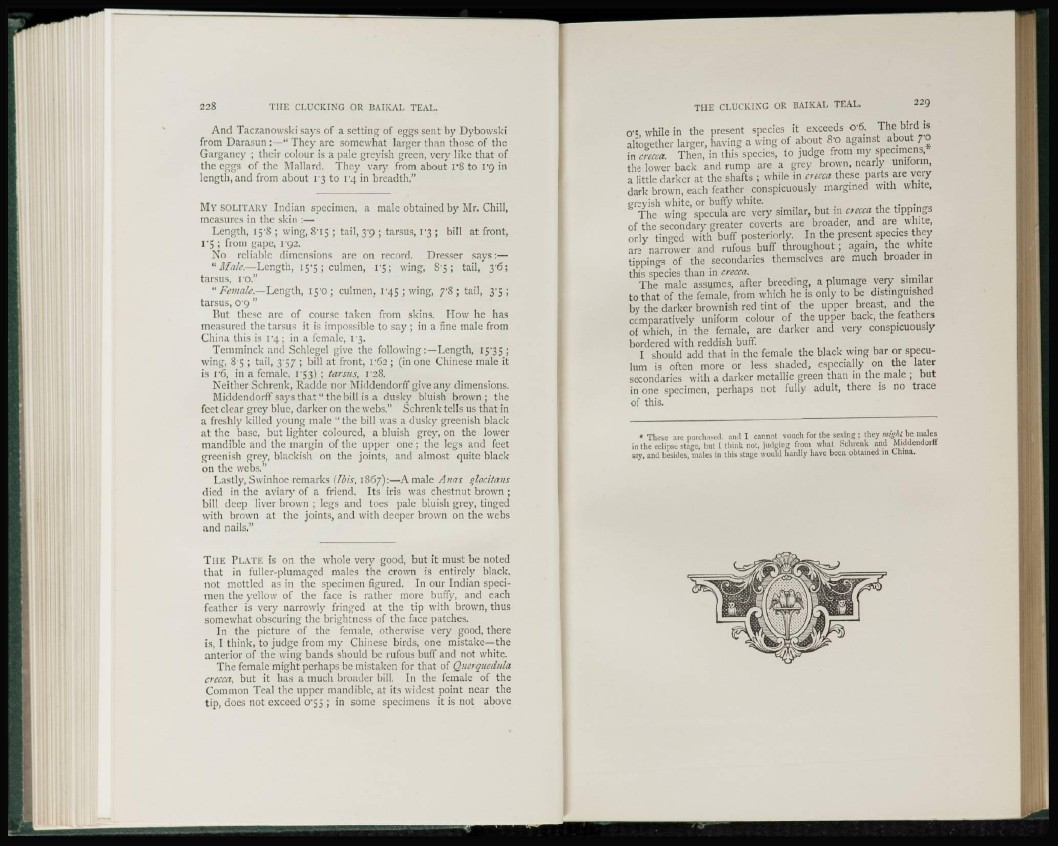
And Taczanowski says of a setting of eggs sent by Dybowski
from Darasun :—"They are somewhat larger than those of the
Garganey ; their colour is a pale greyish green, very like that of
the eggs of the Mallard. They vary from about i-8 to ro in
length, and from about l'3 to l'4 in breadth."
MY SOLITARY Indian specimen, a male obtained by Mr. Chill,
measures in the skin :—•
Length, 158 ; wing, 8-15 ; tail, yg ; tarsus, 13 ; bill at front,
I'5 ; from gape, i"Q2.
No reliable dimensions are on record. Dresser says:—
"Male.—Length, 15-5; culmen, wing, 8-5; tail, 3'6;
tarsus, 1 o."
"Female.—Length, I5'0; culmen, 1 4 5 ; wing, 7'8 ; tail, 3'5 ;
tarsus, 0 9 "
But these arc of course taken from skins. How he has
measured the tarsus it is impossible to say ; in a fine male from
China this is 1*4 ; in a female, 13.
Temminck and Schlegel give the following:—Length, I5'35 ;
wing, 85 ; tail, 3*57 ; bill at front, r62 ; (in one Chinese male it
is 1'6, in a female, 1*53) ; tarsus, 128.
Neither Schrenk, Radde nor Middendorff give any dimensions.
Middcndorff says that " the bill is a dusky bluish brown; the
feet clear grey blue, darker on the webs." Schrenk tells us that in
a freshly killed young male "the bill was a dusky greenish black
at the base, but lighter coloured, a bluish grey, on the lower
mandible and the margin of the upper one; the legs and feet
greenish grey, blackish on the joints, and almost quite black
on the webs."
Lastly, Swinhoe remarks (Ibis, 1867):—-A male Anas olocitans
died in the aviary of a friend. Its iris was chestnut brown ;
bill deep liver brown ; legs and toes pale bluish grey, tinged
with brown at the joints, and with deeper brown on the webs
and nails."
T l I E PLATE is on the whole very good, but it must be noted
that in fuller-plumagcd males the crown is entirely black,
not mottled as in the specimen figured. In our Indian specimen
the yellow of the face is rather more buffy, and each
feather is very narrowly fringed at the tip with brown, thus
somewhat obscuring the brightness of the face patches.
In the picture of the female, otherwise very good, there
is, I think, to judge from my Chinese birds, one mistake—the
anterior of the wing bands should be rufous buff and not white.
The female might perhaps be mistaken for that of Qncrqucdula
ereeca, but it has a much broader bill. In the female of the
Common Teal the upper mandible, at its widest point near the
tip, does not exceed 0'5 5 ; in some specimens it is not above
o'5, while in the present species it exceeds 06. The bird is
altogether larger, having a wing of about S'O against about 7'0
in ereeca. Then, in this species, to judge from my specimens,*
the lower back and rump are a grey brown, nearly uniform,
a little darker at the shafts ; while in ereeca these parts are very
dark brown, each feather conspicuously margined with white,
greyish white, or buffy white.
The wing specula are very similar, but in crecca the tippings
of the secondary greater coverts are broader, and are white,
only tinged with buff posteriorly. In the present species they
are narrower and rufous buff throughout ; again, the white
tippings of the secondaries themselves are much broader in
this species than in crecca.
The male assumes, after breeding, a plumage very similar
to that of the female, from which he is only to be distinguished
by the darker brownish red tint of the upper breast, and the
comparatively uniform colour of the upper back, the feathers
of which, in the female, are darker and very conspicuously
bordered with reddish buff.
I should add that in the female the black wing bar or speculum
is often more or less shaded, especially on the later
secondaries with a darker metallic green than in the male ; but
in one specimen, perhaps not fully adult, there is no trace
of this.
• T h e s e are purchased, ami I cannot vouch for the sexing; they might be nudes
in the eclipse stage, but I think not, judging from what Schrenk and Middendorff
say, and besides, males in this stage would hardly have been obtained in China.